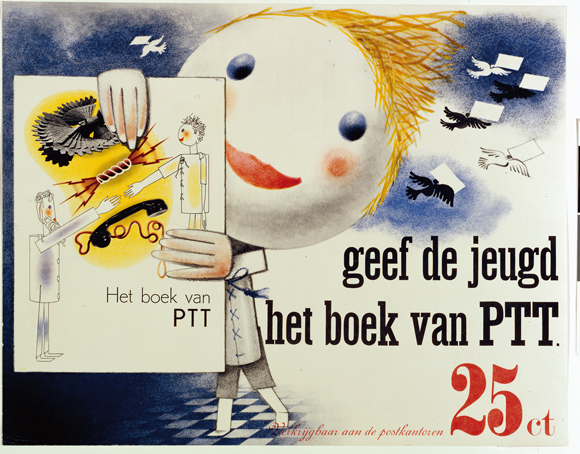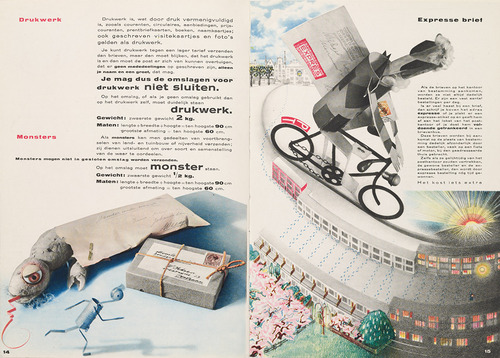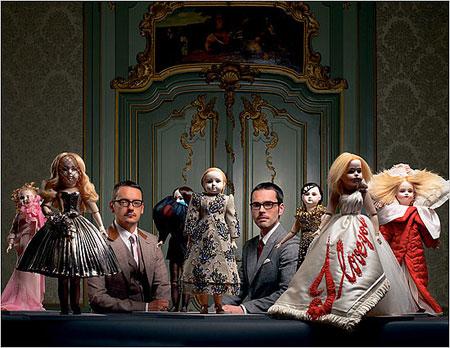The bauhaus might be quite interesting and new for some, but looking at the collection it only makes me realise how many works of theirs I see in daily life, without being aware of their background.
In the midst of it all there was one piece by Piet Zwart that caught my attention, the postal office dolls . The reason why his work interested me the most was not because of its material or colours but its size. Other works in the Bauhaus were on such a big scale, or photos of bigger works, that these small dolls made them even more noticeable for me.
Afterwards I did some research at home on Piet Zwart and his other works by looking at a documentary on him called ‘Everything Must Change’, by Sherman De Jesus, 2012[x]. What I found out during my research was that, he wanted to design his own identity, he wanted to see what Piet Zwart looked like. Writing doctrines, manifestos, mantras and disciplines, of various forms of the avant-garde, and knowing them well, was his first step in breaking the conventions. Three of his biggest influences were Russian constructivism, Dada and the De Stijl movement [x].
He studied a diverse range of art related subjects including painting and architecture, and he was introduced to the principles of the English Arts and Crafts movement. From 1908 he started teaching at an industrial and domestic school for girls. In 1913 he returned to study, attending the University of technology in Delft for a year. From 1919 while continuing to work as an independent designer, he began teaching at the Rotterdam Academy of Visual Arts, now known as the Willem de Kooning Academy. He was dismissed in 1933 because of what were considered his radical ideas on education. His ideas were too similar to those of the Bauhaus art school in Germany, where he gave some guest lectures as well in 1929.
In 1930 he was asked to design ‘The Book of PTT’. This book was made to teach school children how to use the Dutch postal service. It was full of bright colors and it was meant to be exciting. He created two main characters for the book: ‘The Post’ and ‘J Self’ [See Dolls 1] They were paper doll cut-outs that he photographed and then touched up with chalk, ink, and color pencil. Additionally, he used many different fonts of varying sizes and thicknesses. He was assisted in illustrating the book by Dick Elffers. The book was finally published in 1938.
I studied him up to this point because it seemed to me like his later works would be irrelevant to how I relate to the dolls. So after the research of his earlier years and how he worked on The Book of PTT, I finally found a connection. As a child I used to make a lot of dolls out of a wide variety of materials for example; clay, paper, trash, etc. I made their clothes and homes, I created a separate world for them. And I would link those to a story in my head or on paper. The reason I felt connected with his dolls was because it gave me a nostalgic feeling of how I used to play and the way I produced the dolls and linked them to my stories felt similar to Piet Zwart’s dolls and The Book of PTT.
Even though I might find them very similar, at the same time, to me they are totally different. For example the way he executes his stories in his book he uses a very precise and fixed style that doesn’t change throughout the book whereas in my case I was still a child, I did not have a fixed style; my drawings were childishly disorganized.
Another difference is his typography, not only the way he writes but the way he uses words and letters. It seems like he’s playing with them, something I could’ve only dreamed of as a child. I wasn’t really the smooth talker, I often stuttered and could never get my words across.
As for his writing of course it can’t be compared to that of a child’s handwriting even if it is made for children. Even now writing is not really one of my strong suits, a reason why I came to the Rietveld, to improve my writing skills in order to get my stories across. That’s why my stories were told mostly by images instead of text.
I hope to have to opportunity of honing my writing skills at the Rietveld Academy so that I can explore and find my own new way of writing. That would clarify the meaning of the stories I have yet to tell.
Sources:
-Piet Zwart en Het boek van PTT, [x] Een commentaar, Paul Hefting, 1982
or have a look at the boek itself [x]
-Pioneers of Modern Typography, Herbert Spencer, London, 1983










